A Quantified Methodology for Evaluating Engineering Sustainability: Ecological Footprint Measurement Modeling
Abstract
:1. Introduction
2. Literature Review
3. Research Methodology and Theoretical Basis
3.1. Research Framework
3.2. Construction Project Stakeholders
3.3. Ecological Footprint and Ecological Carrying Capacity Theory
3.3.1. Ecological Footprint Theory
3.3.2. Equalization and Yield Factors
3.3.3. Ecological Footprint Measurement
3.3.4. Calculation of Ecological Carrying Capacity
3.3.5. Ecological Deficit and Ecological Redundancy
4. Analysis of Internal Relations in Engineering Projects Based on the Ecological Perspective
4.1. Division and Analysis of the Whole Life Cycle Stages of Engineering Projects
4.2. Analysis of Construction Project Ecosystems and Their Internal Framework
5. Ecological Footprint Measurement Model for the Whole Life Cycle of Engineering Projects
5.1. Model Construction Ideas
5.2. Basic Framework of the Model
5.3. Project Life Cycle Ecological Footprint Measurement Model
5.3.1. Coordination Factor Coefficient
5.3.2. Equalization Factor Matching
5.3.3. Ecological Footprint Measurement Model for Each Stage of the Whole Life Cycle of a Construction Project
5.4. Model Characteristic Analysis
6. Case Studies and Analysis
6.1. Research Objective
6.2. Model Parameters
6.3. The Whole Life Cycle Ecological Footprint Calculation and Analysis
6.4. Comparative Analysis of the Ecological Footprint of the Project and the Local Ecological Carrying Capacity
7. Conclusions and Future Work
Author Contributions
Funding
Data Availability Statement
Conflicts of Interest
References
- Ding, Z.; Fan, Z.; Tam, V.W.Y.; Bian, Y.; Li, S.; Illankoon, I.M.C.S.; Moon, S. Green building evaluation system implementation. Build. Environ. 2018, 133, 32–40. [Google Scholar] [CrossRef]
- Zhang, Y.; Wang, H.; Gao, W.; Wang, F.; Zhou, N.; Kammen, D.M.; Ying, X. A Survey of the Status and Challenges of Green Building Development in Various Countries. Sustainability 2019, 11, 5385. [Google Scholar] [CrossRef]
- Zuo, J.; Zhao, Z.Y. Green building research–current status and future agenda: A review. Renew. Sustain. Energy Rev. 2014, 30, 271–281. [Google Scholar] [CrossRef]
- Yin, B.C.L.; Laing, R.; Leon, M.; Mabon, L. An evaluation of sustainable construction perceptions and practices in Singapore. Sustain. Cities Soc. 2018, 39, 613–620. [Google Scholar] [CrossRef]
- Sfakianaki, E. Management of environmental quality: An international journal critical success factors for sustainable construction: A literature review article information. Manag. Environ. Qual. Int. J. 2019, 30, 176–196. [Google Scholar] [CrossRef]
- Mohammed, M.; Shafiq, N.; Abdallah, N.A.W.; Ayoub, M.; Haruna, A. A review on achieving sustainable construction waste management through application of 3R (reduction, reuse, recycling): A lifecycle approach. IOP Conf. Ser. Earth Environ. Sci. 2020, 476, 012010. [Google Scholar] [CrossRef]
- Hossain, M.U.; Ng, S.T.; Antwi-Afari, P.; Amor, B. Circular economy and the construction industry: Existing trends, challenges and prospective framework for sustainable construction. Renew. Sustain. Energy Rev. 2020, 130, 109948. [Google Scholar] [CrossRef]
- Hoxha, E.; Habert, G.; Lasvaux, S.; Chevalier, J.; Le Roy, R. Influence of construction material uncertainties on residential building LCA reliability. J. Clean. Prod. 2017, 144, 33–47. [Google Scholar] [CrossRef]
- Cengiz, A.A.E.; Aytekin, B.O.; Ozdemir, B.I.; Kusan, B.H.; Cabuk, A.A. A Multi-criteria Decision Model for Construction Material Supplier Selection. Procedia Eng. 2017, 196, 294–301. [Google Scholar] [CrossRef]
- Zhou, H. Research on the Symbiotic Interaction between Large-scale Engineering and Ecology. Sci. Technol. Prog. Policy 2008, 10, 44–47. [Google Scholar]
- Shao, Q.; Cao, W.; Fan, J.; Huang, L.; Xu, X. Ecological Effect Evaluation of the First Phase of the Sanjiangyuan Ecological Protection and Construction Project. J. Geogr. Sci. 2017, 27, 183–204. [Google Scholar] [CrossRef]
- Xu, X.; Ni, Z.; Shen, Z.; Wang, N.; Liu, B. Study on the Ecological Environmental Impact and Evaluation Indicator System of Inter-Basin Water Transfer Projects in the Water Source Area. Ecol. Econ. 2018, 34, 174–178. [Google Scholar]
- Zhang, D.; Yang, S.; Wang, Z.; Yang, C.; Chen, Y. Assessment of ecological environment impact in highway construction activities with improved group AHP-FCE approach in China. Environ. Monit. Assess. 2020, 192, 451. [Google Scholar] [CrossRef]
- Liu, J.; Wang, Y.; Wang, Y.; Wang, D. Problems and Suggestions on the Development of Green Building Design Standard System. Sci. Found. China 2023, 37, 360–363. [Google Scholar]
- Yuan, W.; Zhou, X. Overview of Research Progress on Ecological Compensation Abroad. China Popul. Resour. Environ. 2014, 24, 76–82. [Google Scholar]
- He, S.; Wang, D.; Fang, Y.; Lan, H. Guidelines for integrating ecological and biological engineering technologies for control of severe erosion in mountainous areas—A case study of the Xiaojiang River Basin, China. Int. Soil Water Conserv. Res. 2017, 5, 335–344. [Google Scholar] [CrossRef]
- Xie, G.D. Research on the Construction of National Ecological Security Maintenance Mechanism. Environ. Prot. 2018, 46, 13–16. [Google Scholar]
- Li, L.; Lu, Y.C. Analysis of Ecological Environmental Protection in the Construction of the Huaqiao Water Conservancy Hub Project. People’s Yellow River 2021, 43, 242–243. [Google Scholar]
- Lü, J.W.; Liu, B. Preliminary Discussion on Establishing a Forest Carbon Sink Ecological Compensation Mechanism in China. Agric. Econ. 2023, 8, 116–117. [Google Scholar]
- Zhang, T.; Wu, J.J.; Le, Y. Calculation Method for Total Life Cycle CO2 Emissions of Building Materials. J. Eng. Manag. 2012, 26, 23–26. [Google Scholar]
- Du, X.W.; Qian, Y.; Chen, Y.; Ling, J.; Liu, X.L.; Yang, B.; Jiang, L.L.; Ge, Q.; Huo, H.T.; Liu, X.; et al. Strategic Research on the Classification and Resource Utilization of Solid Waste in China. Chin. Eng. Sci. 2017, 19, 27–32. [Google Scholar]
- Chen, Y.; Hu, N.; Teng, J.J.; Liu, X.; Li, Y.; Ling, J. Research on the Resource Utilization Strategy for Industrial Solid Waste in China. Chin. Eng. Sci. 2017, 19, 109–114. [Google Scholar]
- Li, Z.; Lin, B.; Zheng, S.; Liu, Y.; Wang, Z.; Dai, J. A review of operational energy consumption calculation method for urban buildings. Build. Simul. 2020, 13, 739–751. [Google Scholar] [CrossRef]
- Ren, X.S.; Li, Z.R. Evolution and Influencing Factors of Spatial Correlation Network of Construction Carbon Emission in China from the Perspective of Whole Life Cycle. Huanjing Kexue 2024, 45, 1243–1253. [Google Scholar]
- Jayasinghe, L.B.; Waldmann, D. Development of a BIM-Based Web Tool as a Material and Component Bank for a Sustainable Construction Industry. Sustainability 2020, 12, 1766. [Google Scholar] [CrossRef]
- Khan, S.A.; Koc, M.; Al-Ghamdi, S.G. Sustainability assessment, potentials and challenges of 3D printed concrete structures: A systematic review for built environmental applications—ScienceDirect. J. Clean. Prod. 2021, 303, 127027. [Google Scholar] [CrossRef]
- He, Z.; Wang, B.; Huang, D.; Fang, J. Stakeholder Conflict Amplification of Large-Scale Engineering Projects in China: An Evolutionary Game Model on Complex Networks. Complexity 2020, 2020, 9243427. [Google Scholar] [CrossRef]
- Lu, Y.; Zhang, Y. Toward a Stakeholder Perspective on Safety Risk Factors of Metro Construction: A Social Network Analysis. Complexity 2020, 2020, 8884304. [Google Scholar] [CrossRef]
- Mitchell, R.K.; Agle, B. Toward a Theory of Stakeholder Identification and Salience: Defining the Principle of who and What Really Counts. Acad. Manag. Rev. 1997, 22, 853–886. [Google Scholar] [CrossRef]
- Xu, Z.M.; Cheng, G.D.; Zhang, Z.Q. Theoretical Analysis of the Ecological Footprint Method. China Popul. Resour. Environ. 2006, 6, 69–78. [Google Scholar]
- Kitzes, J.; Wackernagel, M. Answers to common questions in Ecological Footprint accounting. Ecol. Indic. 2009, 9, 812–817. [Google Scholar] [CrossRef]
- Niccolucci, V.; Galli, A.; Reed, A.; Neri, E.; Wackernagel, M.; Bastianoni, S. Towards a 3D National Ecological Footprint Geography. Ecol. Model. 2011, 222, 2939–2944. [Google Scholar] [CrossRef]
- Niccolucci, V.; Bastianoni, S.; Tiezzi, E.B.P.; Wackernagel, M.; Marchettini, N. How deep is the footprint? A 3D representation. Ecol. Model. 2009, 220, 2819–2823. [Google Scholar] [CrossRef]
- Li, Z.F.; Gao, J.; Zhong, Y. Research on the Ecological Security Assessment of Grasslands in Tibet: Based on an Improved Ecological Footprint Model with Ecosystem Service Value. Arid Zone Resour. Environ. 2023, 37, 9–19. [Google Scholar]
- Guo, H.; Dong, S.W.; Wu, D.; Pei, S.X.; Xin, X.B. Calculation of Equilibrium Factors and Yield Factors in the Ecological Footprint Model Based on Ecosystem Service Value. Acta Ecol. Sin. 2020, 40, 1405–1412. [Google Scholar]
- De Alvarenga, R.A.F.; Da Silva Júnior, V.P.; Soares, S.R. Comparison of the ecological footprint and a life cycle impact assessment method for a case study on Brazilian broiler feed production. J. Clean. Prod. 2012, 28, 25–32. [Google Scholar] [CrossRef]
- Zhang, H.Y.; Liu, W.D.; Wang, S.Z.; Shan, N.N.; Liang, H.M. Calculation of Equilibrium Factors and Yield Factors in the “Provincial Hectare” Ecological Footprint Model: A Case Study of Zhejiang Province. J. Nat. Resour. 2009, 24, 82–92. [Google Scholar]
- Liu, Y.Z.; Zhou, X.; Chen, Y.; Zhang, Z.; Zhou, L.L. Ecological footprint-based environmental impact assessment of structural adjustment objectives for overall land utilization planning. J. Anim. Plant Sci. 2015, 25, 99–106. [Google Scholar]
- Zhang, X.X.; Zeng, H. Dynamic Changes and Driving Force Analysis of the Three-Dimensional Ecological Footprint in the Pearl River Delta Urban Agglomeration. J. Environ. Sci. 2017, 37, 771–778. [Google Scholar]
- Zhang, J.H.; Zhang, J. Advances and Insights in Domestic Ecological Footprint Model Research. Reg. Res. Dev. 2007, 2, 90–96. [Google Scholar]
- Salvo, G.; Simas, M.S.; Pacca, S.A.; Guilhoto, J.J.M.; Tomas, A.R.G.; Abramovay, R. Estimating the human appropriation of land in Brazil by means of an Input–Output Economic Model and Ecological Footprint analysis. Ecol. Indic. 2015, 53, 78–94. [Google Scholar] [CrossRef]
- Cano-Orellana, A.; Delgado-Cabeza, M. Local ecological footprint using Principal Component Analysis: A case study of localities in Andalusia (Spain). Ecol. Indic. 2015, 57, 573–579. [Google Scholar] [CrossRef]
- Ke, Z.C.; Lian, H.F.; Chen, Y.; Chen, S.M.; Lin, X.Y. Spatiotemporal Dynamics of Per Capita Ecological Footprint and Per Capita Ecological Carrying Capacity in Fujian Province from 2009 to 2018. J. Fujian Agric. For. Univ. (Nat. Sci. Ed.) 2021, 50, 677–685. [Google Scholar]
- Zhang, J.R.; Shi, Q.G. Comparative Study on the Ecological Carrying Capacity Differences in Urban Agglomerations in the Middle Reaches of the Yangtze River. Resour. Environ. Yangtze Basin 2020, 29, 1694–1702. [Google Scholar]
- Wood, R.; Garnett, S. An assessment of environmental sustainability in Northern Australia using the ecological footprint and with reference to Indigenous populations and remoteness. Ecol. Econ. 2009, 68, 1375–1384. [Google Scholar] [CrossRef]
- Liu, L.L.; Wei, L.X.; Xu, Y.; Xin, X.G.; Xiao, C. Estimation of the Impact of Climate Change on Ecological Runoff in the Yellow River Basin. Adv. Water Sci. 2021, 32, 824–833. [Google Scholar]
- Mostafa, M.M. A Bayesian approach to analyzing the ecological footprint of 140 nations. Ecol. Indic. 2010, 10, 808–817. [Google Scholar] [CrossRef]
- Wiedmann, T.; Lenzen, M. On the conversion between local and global hectares in Ecological Footprint analysis. Ecol. Econ. 2007, 60, 673–677. [Google Scholar] [CrossRef]
- Ma, L.; Liu, H.; Peng, J.; Wu, J.S. Progress in Research on the Supply and Demand of Ecosystem Services. Acta Geogr. Sin. 2017, 72, 1277–1289. [Google Scholar]
- López-Malest, A.; Gabor, M.R.; Panait, M.; Brezoi, A.; Veres, C. Green Innovation for Carbon Footprint Reduction in Construction Industry. Buildings 2024, 14, 374. [Google Scholar] [CrossRef]
- Yan, J.; Lu, Q.; Tang, J.; Chen, L.; Hong, J.; Broyd, T. Digital tools for revealing and reducing carbon footprint in infrastructure, building, and city scopes. Buildings 2022, 12, 1097. [Google Scholar] [CrossRef]
- Shadram, F.; Mukkavaara, J. Improving life cycle sustainability and profitability of buildings through optimization: A case study. Buildings 2022, 12, 497. [Google Scholar] [CrossRef]
- World Wide Fund for Nature. “China Ecological Footprint Report 2012” Released. Environ. Prot. Circ. Econ. 2012, 32, 33. [Google Scholar]
- Qian, K. Evaluation of Ecological Footprint of Construction Projects Based on Energy Consumption. Master’s Thesis, Tsinghua University, Beijing, China, 2010. [Google Scholar]
- Wu, S.H. Calculation and Evaluation of Ecological Footprint for Green Buildings. Master’s Thesis, Xi’an University of Architecture and Technology, Xi’an, China, 2011. [Google Scholar]
- Zang, P.; Shao, B.L. Study on Evaluation Methods of Green Building from an Ecological Perspective. J. Build. Sci. 2014, 30, 19–23. [Google Scholar]
- Chen, H.Y.; Teng, J.Y.; Wang, Y.Y.; Wu, X.G.; Qin, Y.W. Research on Ecological Benefit Evaluation of Construction Projects Based on Ecological Footprint. J. Eng. Manag. 2017, 31, 107–111. [Google Scholar]
- Jiang, X.X. Low Carbonization Benefit Evaluation of Rural Residential Construction. Master’s Thesis, Huazhong University of Science and Technology, Wuhan, China, 2011. [Google Scholar]
- Li, B. Research on Low Carbon Building Technology Systems and Carbon Emission Calculation Methods. Ph.D. Thesis, Huazhong University of Science and Technology, Wuhan, China, 2012. [Google Scholar]
- Wang, H.L.; Zhuang, Q.H.; Mao, W.J. Quzhou Sports Stadium: Marching Towards a New Era with the City. Quzhou Daily, 30 June 2023; p. 4. [Google Scholar]
- Zhong, P. Research on Energy Consumption and Environmental Impact of Building Life Cycle. Master’s Thesis, Sichuan University, Chengdu, China, 2005. [Google Scholar]
- Bessa, V.M.T.; Prado, R.T.A. Methodology of CO2 emissions evaluation in the life cycle of office building façades. Environ. Impact Assess. Rev. 2012, 33, 41–47. [Google Scholar]
- Wei, J.X.; Geng, Y.B.; Shen, L.; Cen, K.; Mu, Y. Calculation of Carbon Emission Factors Based on the Current Status of Cement Production in China. China Environ. Sci. 2014, 34, 2970–2975. [Google Scholar]
- Ge, J.C.; Huang, J.; Lai, Y.N.; Xue, F.; Chen, X.T. Analysis of Calculation Standards and Specifications for Carbon Emission Factors in Domestic and International Power Grids. Glob. Energy Interconnect. 2024, 1–13. [Google Scholar]
- Luo, P.-Y. Research on Carbon Emission Factors in Building Construction. Master’s Thesis, Guangdong University of Technology, Guangzhou, China, 2016. [Google Scholar]
- Chen, H.Y.; Teng, J.Y.; Wang, Y.Y.; Wu, X.G.; Qin, Y.W. A Calculation Model for the Ecological Footprint of Construction Projects Throughout the Entire Life Cycle. J. Civ. Eng. Manag. 2018, 35, 130–134. [Google Scholar]
- Teng, J.Y.; Wu, X.G.; Ran, L.Y.; Qin, Y.W.; Liu, H.T. Evaluation of Ecological Sustainability of Construction Projects Based on Ecological Footprint. Civ. Archit. Environ. Eng. 2016, 38, 104–108. [Google Scholar]
- Cui, P.; Li, D.Z.; Ang, S.L.; Li, Q.M. Study on the Measurement Method of Ecological Efficiency in the Whole Life Cycle of Residential Buildings. Constr. Econ. 2013, 11, 96–99. [Google Scholar]
- Jing, P.R.; Guo, L.D. Study on the Coordinated Development of Water Resources Utilization and Economic in Zhejiang Province Based on Ecological Footprint. Water Resour. Hydropower Eng. (Chin. Engl.) 2021, 52, 42–51. [Google Scholar]
- Si, G.J.; Zou, Y.J.; Kong, J.H. Analysis of Urban Resilience and Its Spatiotemporal Changes in Zhejiang Province. J. Ningbo Univ. (Sci. Eng. Ed.) 2023, 36, 113–120. [Google Scholar]
- Ma, S.; Xue, M.; Ji, S.; Powe, D.N.; Willis, D.K.; Page, G.B. An improved emergy ecological footprint method f or ecological security assessment and quantitative analysis of influencing factors: A case study of Zhejiang Province. J. Environ. Plan. Manag. 2023, 66, 2878–2902. [Google Scholar] [CrossRef]
- Gang, Y. Planning Study of Public Sports Facilities in the Central Urban Area of Quzhou City. Master’s Thesis, Xi’an University of Architecture and Technology, Xi’an, China, 2018. [Google Scholar]
- Li, G.Z. Study on the Spatiotemporal Differences and Factor Decomposition of Ecological Footprint in Zhejiang Province. J. East China Norm. Univ. (Nat. Sci. Ed.) 2018, 4, 147–158. [Google Scholar]
- Shen, W.T.; Hu, Q.G. Calculation of Ecological Footprint in Zhejiang Province and Analysis of Its Spatiotemporal Differentiation Characteristics. Sci. Manag. 2017, 19, 7–13+24. [Google Scholar]
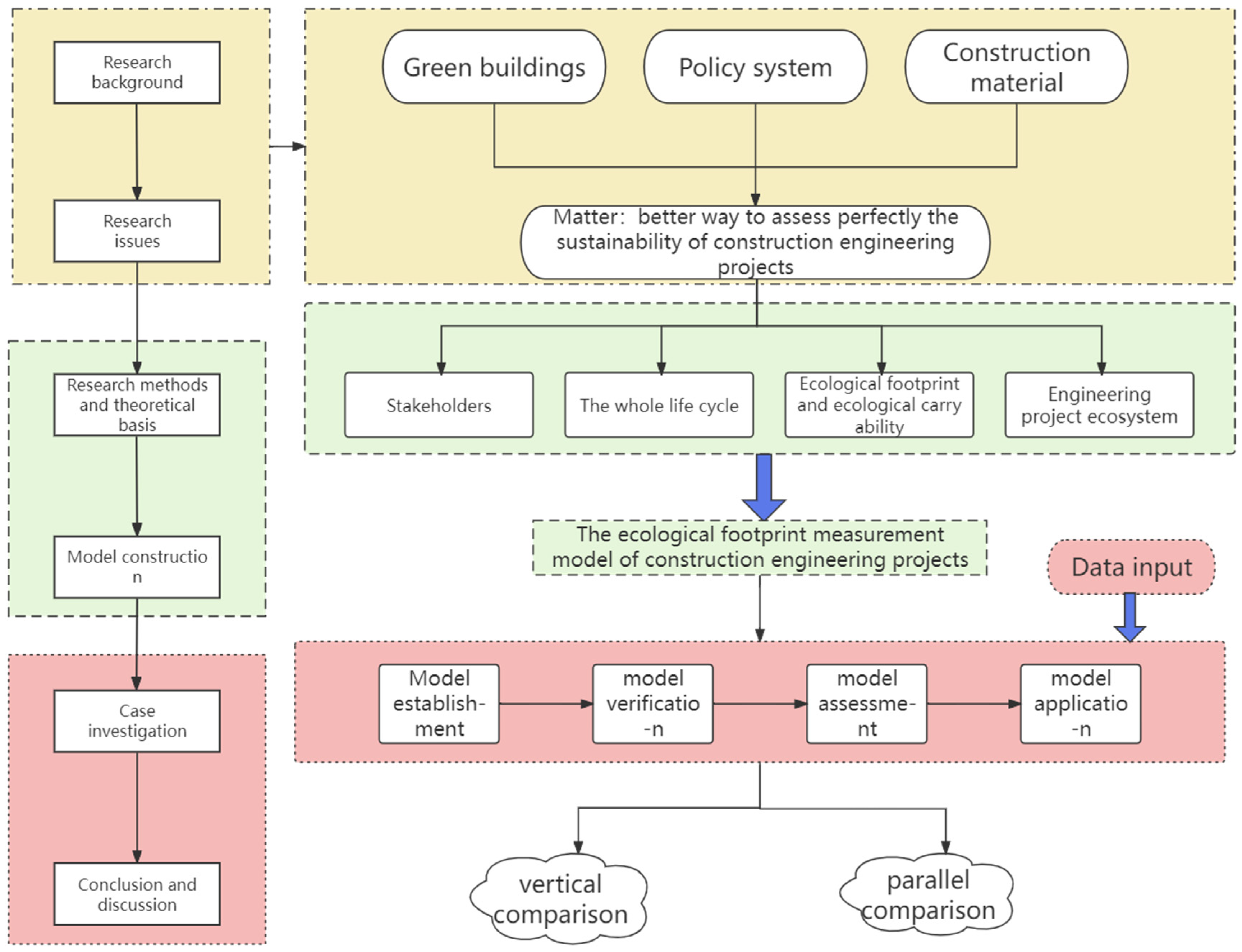
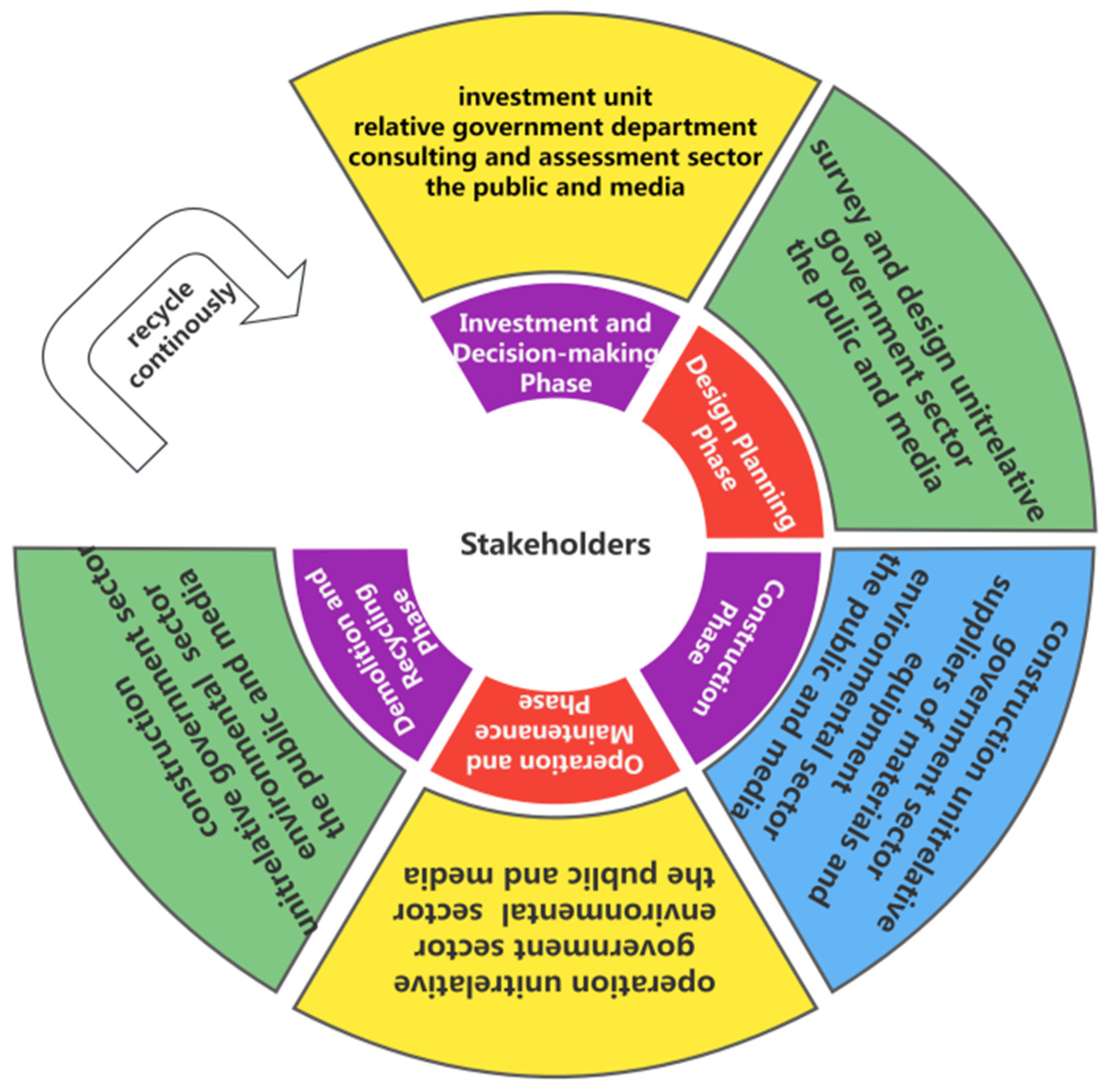
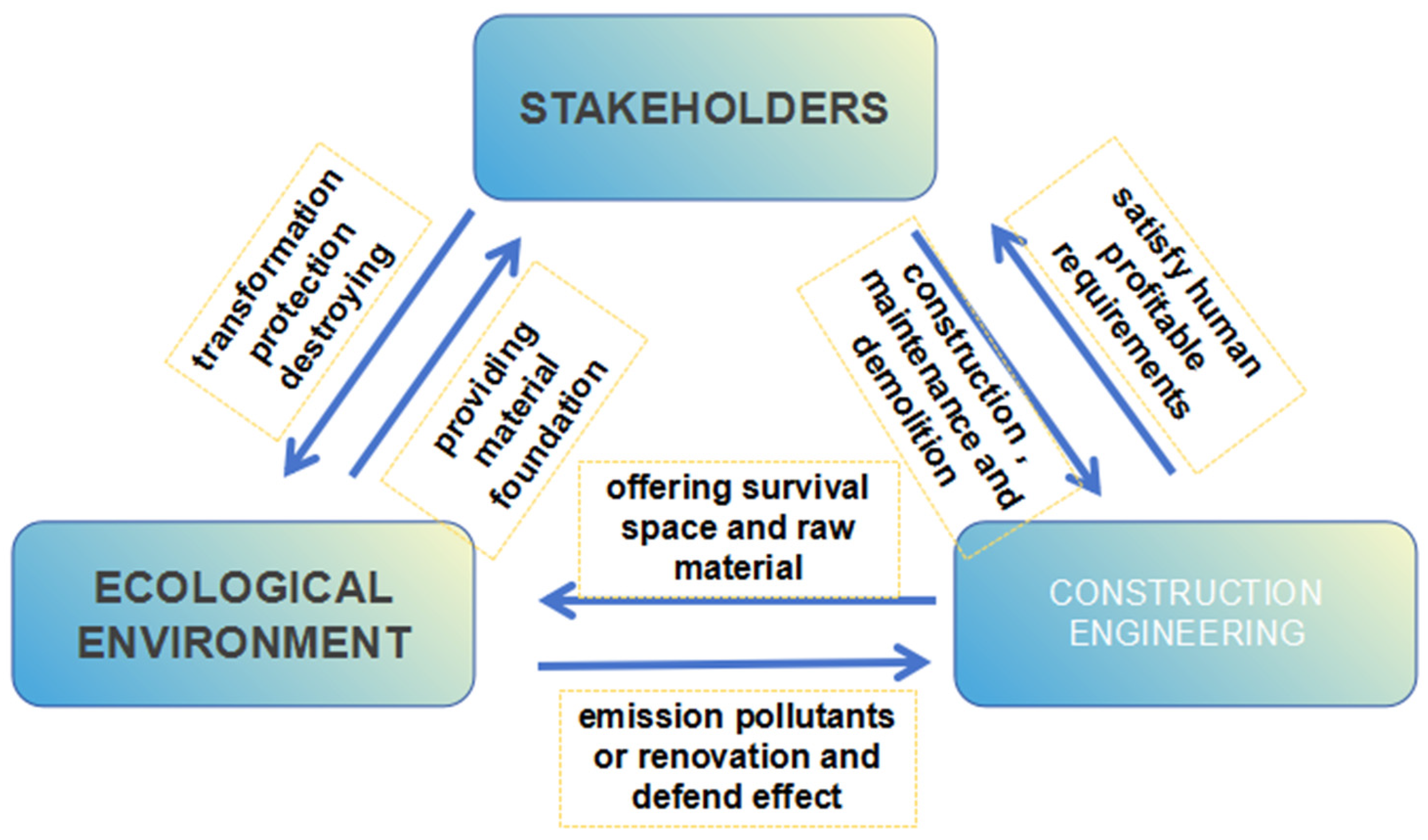
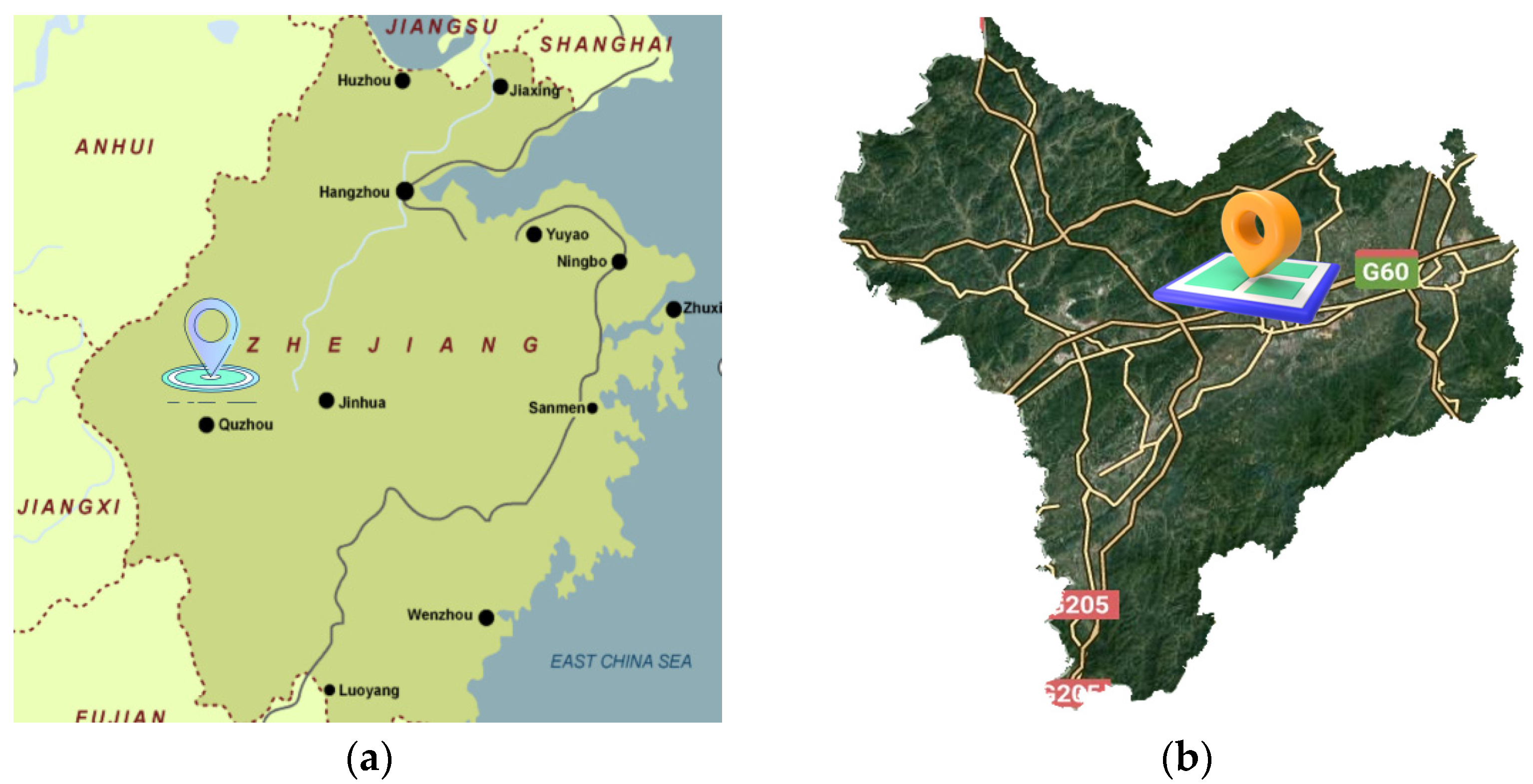



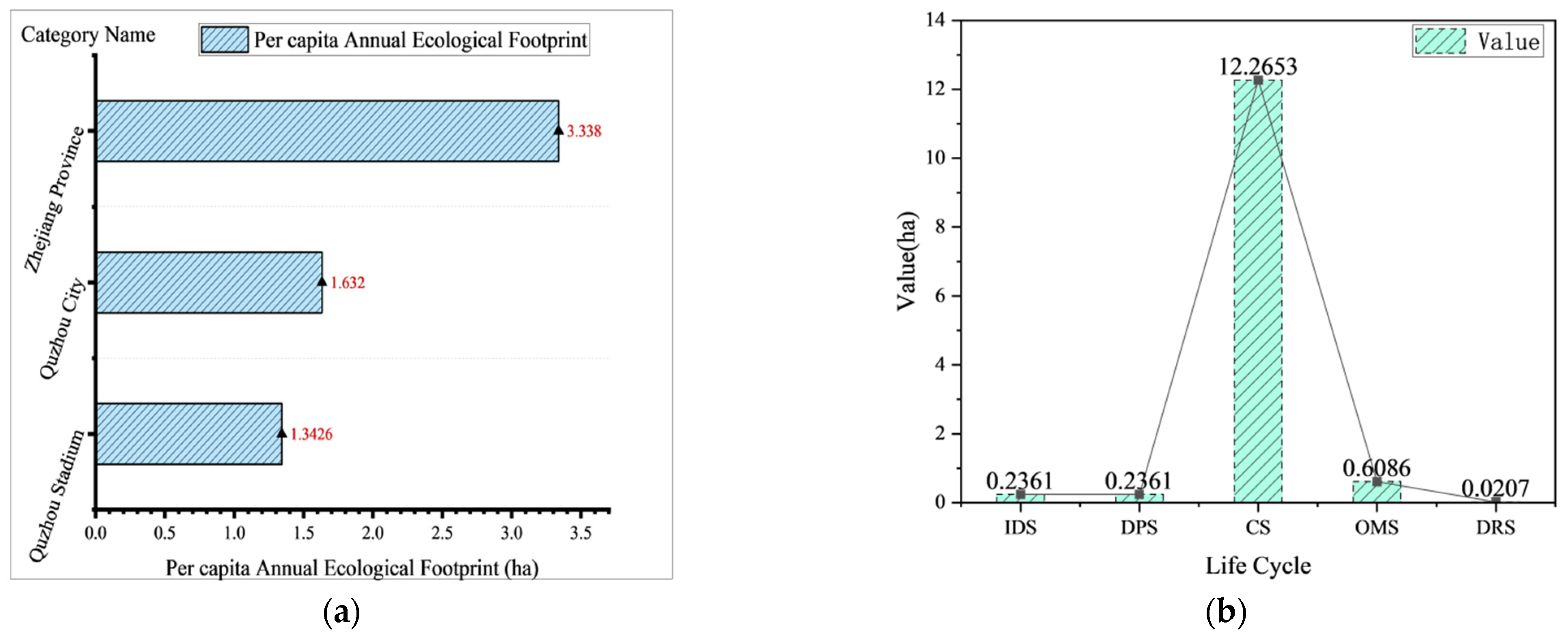

| Serial Number | Dominant Stakeholders | Serial Number | Auxiliary Stakeholders |
|---|---|---|---|
| SH1 | Investment unit | SH6 | Relevant government departments |
| SH2 | Survey and design unit | SH7 | Suppliers of materials and equipment |
| SH3 | Construction unit | SH8 | Environmental sector |
| SH4 | Supervisory unit | SH9 | Consulting assessment sector |
| SH5 | Operating unit | SH10 | The masses |
| SH11 | News media |
| Land Type | Equalization Factor Value |
|---|---|
| arable land | 2.51 |
| grassland | 0.46 |
| Fossil fuel land | 1.26 |
| construction land | 2.51 |
| water area | 0.37 |
| forested land | 1.26 |
| Stakeholder (All Phases of the Life Cycle) | Impact on the Ecosystem |
|---|---|
| investment unit (investment and decision-making phase) | All-round assessment of the feasibility of engineering and construction programs. Preparation of environmental impact reports for construction projects. Attitude of ecological and environmental protection |
| Survey and design unit (design planning phase) | The development and selection of design solutions involving environmental claims. Environmental concepts and environmental emphasis influence the integration of subsequent engineering entities with the environment. |
| Construction unit (construction phase) | Awareness and attention to environmental issues. Prevention and treatment of various types of pollutants in the construction process. |
| Supervisory unit (construction phase) | Supervision and correction of all types of behavior of construction units. Stopping and reporting ecological violations by construction units. |
| Operating unit (operation and maintenance phase) | Carbon emissions from maintaining the normal operation of the construction project. Domestic waste and wastewater from the normal life of the operation unit. |
| Construction unit (demolition and recycling phase) | Carbon emissions from the operation of large-scale demolition equipment, dust and fumes. Disposal of post-demolition solid waste and ecosystem imbalances in construction projects. |
| Point | Investment and Decision-Making Stage | Design Planning Stage | Construction Phase | Operation and Maintenance Phase | Demolition and Recycling Phase |
|---|---|---|---|---|---|
| Affect | |||||
| Categorization | |||||
| Relevant Government Departments | Approving various procedures, reports and assists in supervising. The disposal of other stakeholders’ environmental behaviors. | ||||
| Suppliers of Materials and Equipment | Building materials and equipment. | ||||
| Environmental Sector | Supervise and manage the environmental behavior of each unit | ||||
| Consulting Assessment Sector | Assessment of the extent of environmental impacts | ||||
| The Public and The Media | Utilizing public opinion and the power of the masses. focusing on and revealing the facts of ecological and environmental damage. Exerting pressure on other stakeholders concerned to improve the environmental situation. | ||||
| Energy, Resources and Waste Types | Corresponding Biologically Productive Land Types | Unit Land Area |
|---|---|---|
| Steels | Construction land | 0.00056 ha/kg |
| Clinker | Construction land | 0.00023 ha/kg |
| Sand | Water area | 0.00006 ha/kg |
| Waterproofing Membrane | Forested land | 0.00071 ha/kg |
| Crushed or Broken rock | Arable land | 0.00016 ha/kg |
| Wooden Formwork | Forested land | 0.00073 ha/kg |
| Water | Water area | 0.0000006 ha/kg |
| CO2 | Forested land | 0.00021 ha/kg |
| Gasoline | Fossil fuel land | 0.00000012 ha/MJ |
| Diesel Fuel | Fossil fuel land | 0.00000005 ha/MJ |
| Electrical Power | Fossil fuel land | 0.00008 ha/kwh |
| Construction Waste | Arable land | 0.00000000067 ha/kg |
| Building Material | Quantity Consumed (t) |
|---|---|
| Steels | 960 |
| Cement | 62,366 |
| Sand | 49,609 |
| Waterproof Membrane | 2669 |
| Crushed or Broken Rock | 116,763 |
| Water | 15,600 |
| Type of Construction Activity | Energy Consumption |
|---|---|
| Construction Site Clearance | 11 MJ/m2 |
| Material Stacking Area Organization | 6 MJ/m2 |
| Concrete Mixing | 163 MJ/t |
| Excavation and Removal of Earth | 116 MJ/m3 |
| Crane Handling | 53 MJ/t |
| Precast Concrete | 90 MJ/t |
| Temporary Electricity | 523 MJ/m2 |
| Land Grading | 8 MJ/m2 |
| Types | Unit Material Source-Generated Energy |
|---|---|
| Steels | 26.56 MJ/kg |
| Cement | 5.6 MJ/kg |
| Sand | 0.8 MJ/kg |
| Waterproof Membrane | 56.6 MJ/kg |
| Crushed or Broken Rock | 0.3 MJ/kg |
| Water | 0.2 MJ/kg |
| Type of Substance | Carbon Emission Factors |
|---|---|
| Steels | 0.02 kg/MJ |
| Cement | |
| Sand | |
| Waterproof Membrane | 0.0263 kg/MJ |
| Crushed or Broken rock | 0.00866 kg/MJ |
| Water | |
| Gasoline | 0.02986 kg/MJ (2.30 kg/kg) |
| Diesel Fuel | 0.03166 kg/MJ (2.65 kg/kg) |
| Electrical power | 0.00863 kg/kwh (0.83 kg/kwh) |
| Kinds of Substances | Quantities |
|---|---|
| Gasoline | 7365 kg |
| Diesel fuel | 5908 kg |
| Electrical Power | 12,003,600 kwh |
| Water | 176,000,000 kg |
| Garbage | 420,067,630 kg |
| Life Cycle Phases | Ecological Footprint (ha) |
|---|---|
| Investment and Decision-making Stage | 1062.5 |
| Design Planning Stage | 1062.5 |
| Construction Stage | 193,178.27 |
| Operation and Maintenance Stage | 136,903 |
| Demolition and Recycling Stage | 93.39 |
| Total | 332,299.66 |
| Category Name | Per Capita Annual Ecological Footprint (ha) |
|---|---|
| Quzhou Stadium | 1.3426 |
| Investment and Decision-making Stage | 0.2361 |
| Design Planning Stage | 0.2361 |
| Construction Stage | 12.2653 |
| Operation and Maintenance Stage | 0.6086 |
| Demolition and Recycling Stage | 0.0207 |
| Quzhou City | 1.632 |
| Zhejiang Province | 3.338 |
Disclaimer/Publisher’s Note: The statements, opinions and data contained in all publications are solely those of the individual author(s) and contributor(s) and not of MDPI and/or the editor(s). MDPI and/or the editor(s) disclaim responsibility for any injury to people or property resulting from any ideas, methods, instructions or products referred to in the content. |
© 2024 by the authors. Licensee MDPI, Basel, Switzerland. This article is an open access article distributed under the terms and conditions of the Creative Commons Attribution (CC BY) license (https://creativecommons.org/licenses/by/4.0/).
Share and Cite
Jiang, J.; Li, X.; Yu, L.; Jin, J.; Liang, X. A Quantified Methodology for Evaluating Engineering Sustainability: Ecological Footprint Measurement Modeling. Buildings 2024, 14, 3552. https://doi.org/10.3390/buildings14113552
Jiang J, Li X, Yu L, Jin J, Liang X. A Quantified Methodology for Evaluating Engineering Sustainability: Ecological Footprint Measurement Modeling. Buildings. 2024; 14(11):3552. https://doi.org/10.3390/buildings14113552
Chicago/Turabian StyleJiang, Jinli, Xiaojuan Li, Liyan Yu, Jianqiang Jin, and Xian Liang. 2024. "A Quantified Methodology for Evaluating Engineering Sustainability: Ecological Footprint Measurement Modeling" Buildings 14, no. 11: 3552. https://doi.org/10.3390/buildings14113552
APA StyleJiang, J., Li, X., Yu, L., Jin, J., & Liang, X. (2024). A Quantified Methodology for Evaluating Engineering Sustainability: Ecological Footprint Measurement Modeling. Buildings, 14(11), 3552. https://doi.org/10.3390/buildings14113552








